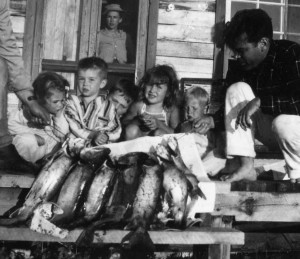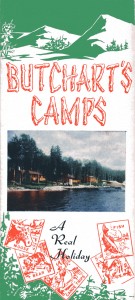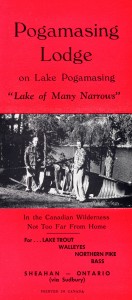
As youngsters growing up at Lake Pogamasing, we were fascinated by the lake trout our parents brought home. Whenever we heard the boats arriving, the cries of “first fish, second fish”, could be heard as we ran to the dock, hoping for the thrill of carrying the fish up the path to show everyone.
In those days lake trout were plentiful, but unfortunately, the days of catching large numbers of trout did not continue. The reasons for this are complex and there are different views about the reasons. What is undeniable, was the importance of lake trout to Pogamasing.
Lake trout for the families on the lake was a sport and a treat that supplemented our weekly supply of store-bought groceries from the city. For the Anishnabe residents of the lake of the 19th century, lake trout was an important staple in their diet. This particularly came home to me as I sought to discover the meaning of Pogamasing.
We grew up believing Pogamasing meant ‘lake of many narrows’, based on the fact that the lake was long and its many bays were joined by narrows. However, Craig MacDonald, a non-Native expert in the Anishnabe language and culture suggested a different meaning for Pogamasing: “water flowing over gravel”.
I was somewhat surprised by his translation as this meaning didn’t connect with what I knew of the lake. Although there were plenty of good sized rocks of five to ten inches, there wasn’t a lot that matched the physical size of gravel. (I have since learned from a fish scientist that this is the ideal size for trout spawning) However, as I discussed other topics with MacDonald I soon came to understand the rationale behind his translation.
Just north of the island where Louis Espagnol lived lies a stretch of rocky, shallow (7 to 10 feet depending on the water level) water which is an excellent spot for lake trout to spawn. It would also be a prime location for the Anishnabe to catch a good supply of trout for the winter. Given that Native names reflect the physical or cultural importance of a place, my hunch is that the Anishnabe called their lake ‘Pogamasing’ because of this critical factor, the place where they could get lake trout.

 Although I have none of their stories to support this theory, I do have many accounts that validate the incredible trout fishing that existed on Pogamasing. Many people I interviewed for my book who lived in the village of Wye during the 1930s talked of the great fishing on Pog. One former villager told me how they caught “buckets of trout” whenever they went fishing. When Jack Miner, the famed conservationist, was looking for a good fishing lake for his son the men on the CPR told him to go Pogamasing. Word got to many more CPR men in Sudbury, such as Joe St. Marseille, Leo Chewick and Earl Pickering and they were some of the first to build camps on the lake after the war. Two fishing lodges, Pogamasing Lodge and Butchart’s Camps also started just after the war to take advantage of the terrific lake trout fishing.
Although I have none of their stories to support this theory, I do have many accounts that validate the incredible trout fishing that existed on Pogamasing. Many people I interviewed for my book who lived in the village of Wye during the 1930s talked of the great fishing on Pog. One former villager told me how they caught “buckets of trout” whenever they went fishing. When Jack Miner, the famed conservationist, was looking for a good fishing lake for his son the men on the CPR told him to go Pogamasing. Word got to many more CPR men in Sudbury, such as Joe St. Marseille, Leo Chewick and Earl Pickering and they were some of the first to build camps on the lake after the war. Two fishing lodges, Pogamasing Lodge and Butchart’s Camps also started just after the war to take advantage of the terrific lake trout fishing.
A broader perspective was given to me by my uncle, Bill Plaunt, who lived at Wye during the 1930s and spent over 60 summers at Pog. He told me: “The trout that we caught used to run between five and twelve pounds. Some days you would only catch two and other days, if you kept them all, you could catch ten or fifteen. And there would be 10 to fifteen boats out everyday. ”
However the excellent fishing did not continue and there was a gradual decline from the forties to the late fifties when one was no longer guaranteed of catching a trout every time you went fishing. My uncle blamed the drop on two factors: the lowering of the water level for two years around 1953 just before spawning season, and the introduction of new species which occurred in the late fifties and early sixties.
For many years I accepted his theory given that my uncle had the longest perspective on the trout fishing on Pog and there was not a lot of evidence for other factors. After a MNR fish survey was conducted in Pog in 2010 I contacted the Ministry to get the survey results and their perspective on the trout decline.
The survey confirmed our worst fears: not one lake trout was caught in their nets and the two new game fish and two other non-game fish dominated the species of fish now in the lake. However, the lack of trout caught does not mean there are no trout in the lake, only that they didn’t get caught in this random sampling. Despite this caution the numbers speak for themselves.
I was also sent a more detailed report on “The Status of Lake Trout Populations in Northeastern Ontario (2000-2005). The scientists’ conclusion was that over fishing, road access and the introduction of new species are the greatest factors affecting lake trout decline over northeastern Ontario. There was no mention of frozen spawn as a factor and road access is still not a factor at Pog, but the heavy fishing in the thirties may have initiated a decline. However, fishing during the war was minimal but the numbers who fished Pog in the late forties and fifties increased but not as heavily as during the thirties. Since we have no other survey reports of previous years we are only left with what the scientists have found in their research in other lakes. One scientist told me the frozen spawn factor may have been a minor contributor but it is too difficult to assess.
And what replaced the lake trout? For that story you’ll have to read “A New Kind of Fishing” in Chapter 15.


{ 0 comments… add one now }